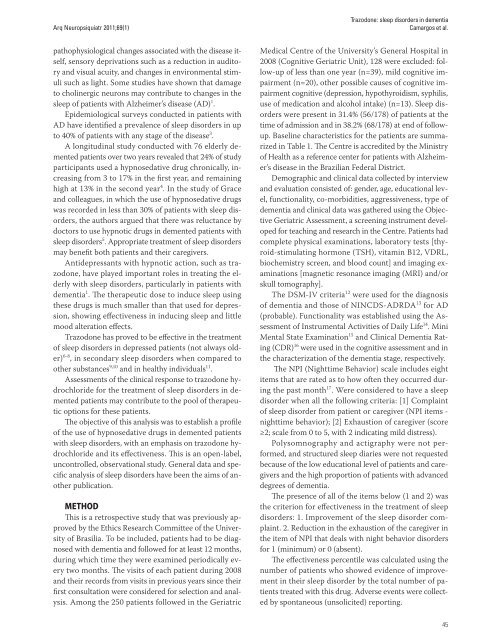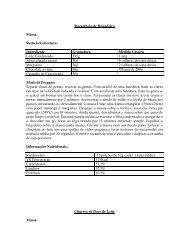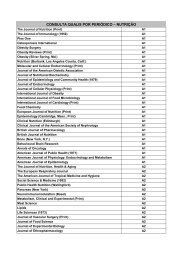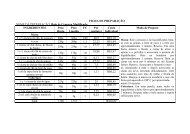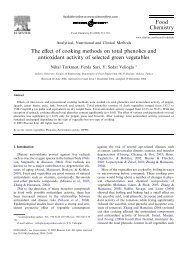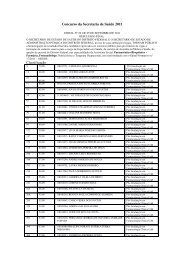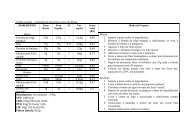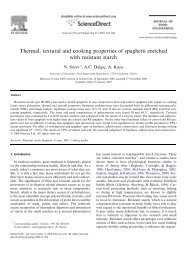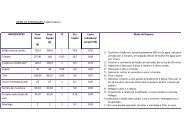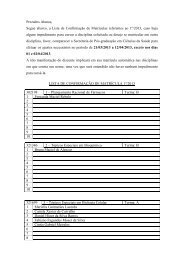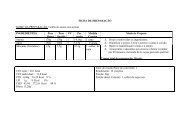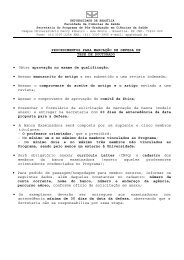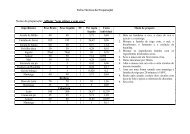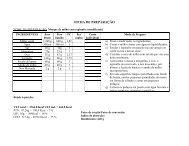Trazodone for the treatment of sleep disorders in dementia - UnB
Trazodone for the treatment of sleep disorders in dementia - UnB
Trazodone for the treatment of sleep disorders in dementia - UnB
Create successful ePaper yourself
Turn your PDF publications into a flip-book with our unique Google optimized e-Paper software.
Arq Neuropsiquiatr 2011;69(1)<br />
<strong>Trazodone</strong>: <strong>sleep</strong> <strong>disorders</strong> <strong>in</strong> <strong>dementia</strong><br />
Camargos et al.<br />
pathophysiological changes associated with <strong>the</strong> disease itself,<br />
sensory deprivations such as a reduction <strong>in</strong> auditory<br />
and visual acuity, and changes <strong>in</strong> environmental stimuli<br />
such as light. Some studies have shown that damage<br />
to chol<strong>in</strong>ergic neurons may contribute to changes <strong>in</strong> <strong>the</strong><br />
<strong>sleep</strong> <strong>of</strong> patients with Alzheimer’s disease (AD) 1 .<br />
Epidemiological surveys conducted <strong>in</strong> patients with<br />
AD have identified a prevalence <strong>of</strong> <strong>sleep</strong> <strong>disorders</strong> <strong>in</strong> up<br />
to 40% <strong>of</strong> patients with any stage <strong>of</strong> <strong>the</strong> disease 3 .<br />
A longitud<strong>in</strong>al study conducted with 76 elderly demented<br />
patients over two years revealed that 24% <strong>of</strong> study<br />
participants used a hypnosedative drug chronically, <strong>in</strong>creas<strong>in</strong>g<br />
from 3 to 17% <strong>in</strong> <strong>the</strong> first year, and rema<strong>in</strong><strong>in</strong>g<br />
high at 13% <strong>in</strong> <strong>the</strong> second year 4 . In <strong>the</strong> study <strong>of</strong> Grace<br />
and colleagues, <strong>in</strong> which <strong>the</strong> use <strong>of</strong> hypnosedative drugs<br />
was recorded <strong>in</strong> less than 30% <strong>of</strong> patients with <strong>sleep</strong> <strong>disorders</strong>,<br />
<strong>the</strong> authors argued that <strong>the</strong>re was reluctance by<br />
doctors to use hypnotic drugs <strong>in</strong> demented patients with<br />
<strong>sleep</strong> <strong>disorders</strong> 5 . Appropriate <strong>treatment</strong> <strong>of</strong> <strong>sleep</strong> <strong>disorders</strong><br />
may benefit both patients and <strong>the</strong>ir caregivers.<br />
Antidepressants with hypnotic action, such as trazodone,<br />
have played important roles <strong>in</strong> treat<strong>in</strong>g <strong>the</strong> elderly<br />
with <strong>sleep</strong> <strong>disorders</strong>, particularly <strong>in</strong> patients with<br />
<strong>dementia</strong> 1 . The <strong>the</strong>rapeutic dose to <strong>in</strong>duce <strong>sleep</strong> us<strong>in</strong>g<br />
<strong>the</strong>se drugs is much smaller than that used <strong>for</strong> depression,<br />
show<strong>in</strong>g effectiveness <strong>in</strong> <strong>in</strong>duc<strong>in</strong>g <strong>sleep</strong> and little<br />
mood alteration effects.<br />
<strong>Trazodone</strong> has proved to be effective <strong>in</strong> <strong>the</strong> <strong>treatment</strong><br />
<strong>of</strong> <strong>sleep</strong> <strong>disorders</strong> <strong>in</strong> depressed patients (not always older)<br />
6-8 , <strong>in</strong> secondary <strong>sleep</strong> <strong>disorders</strong> when compared to<br />
o<strong>the</strong>r substances 9,10 and <strong>in</strong> healthy <strong>in</strong>dividuals 11 .<br />
Assessments <strong>of</strong> <strong>the</strong> cl<strong>in</strong>ical response to trazodone hydrochloride<br />
<strong>for</strong> <strong>the</strong> <strong>treatment</strong> <strong>of</strong> <strong>sleep</strong> <strong>disorders</strong> <strong>in</strong> demented<br />
patients may contribute to <strong>the</strong> pool <strong>of</strong> <strong>the</strong>rapeutic<br />
options <strong>for</strong> <strong>the</strong>se patients.<br />
The objective <strong>of</strong> this analysis was to establish a pr<strong>of</strong>ile<br />
<strong>of</strong> <strong>the</strong> use <strong>of</strong> hypnosedative drugs <strong>in</strong> demented patients<br />
with <strong>sleep</strong> <strong>disorders</strong>, with an emphasis on trazodone hydrochloride<br />
and its effectiveness. This is an open-label,<br />
uncontrolled, observational study. General data and specific<br />
analysis <strong>of</strong> <strong>sleep</strong> <strong>disorders</strong> have been <strong>the</strong> aims <strong>of</strong> ano<strong>the</strong>r<br />
publication.<br />
METHOD<br />
This is a retrospective study that was previously approved<br />
by <strong>the</strong> Ethics Research Committee <strong>of</strong> <strong>the</strong> University<br />
<strong>of</strong> Brasilia. To be <strong>in</strong>cluded, patients had to be diagnosed<br />
with <strong>dementia</strong> and followed <strong>for</strong> at least 12 months,<br />
dur<strong>in</strong>g which time <strong>the</strong>y were exam<strong>in</strong>ed periodically every<br />
two months. The visits <strong>of</strong> each patient dur<strong>in</strong>g 2008<br />
and <strong>the</strong>ir records from visits <strong>in</strong> previous years s<strong>in</strong>ce <strong>the</strong>ir<br />
first consultation were considered <strong>for</strong> selection and analysis.<br />
Among <strong>the</strong> 250 patients followed <strong>in</strong> <strong>the</strong> Geriatric<br />
Medical Centre <strong>of</strong> <strong>the</strong> University’s General Hospital <strong>in</strong><br />
2008 (Cognitive Geriatric Unit), 128 were excluded: follow-up<br />
<strong>of</strong> less than one year (n=39), mild cognitive impairment<br />
(n=20), o<strong>the</strong>r possible causes <strong>of</strong> cognitive impairment<br />
cognitive (depression, hypothyroidism, syphilis,<br />
use <strong>of</strong> medication and alcohol <strong>in</strong>take) (n=13). Sleep <strong>disorders</strong><br />
were present <strong>in</strong> 31.4% (56/178) <strong>of</strong> patients at <strong>the</strong><br />
time <strong>of</strong> admission and <strong>in</strong> 38.2% (68/178) at end <strong>of</strong> followup.<br />
Basel<strong>in</strong>e characteristics <strong>for</strong> <strong>the</strong> patients are summarized<br />
<strong>in</strong> Table 1. The Centre is accredited by <strong>the</strong> M<strong>in</strong>istry<br />
<strong>of</strong> Health as a reference center <strong>for</strong> patients with Alzheimer’s<br />
disease <strong>in</strong> <strong>the</strong> Brazilian Federal District.<br />
Demographic and cl<strong>in</strong>ical data collected by <strong>in</strong>terview<br />
and evaluation consisted <strong>of</strong>: gender, age, educational level,<br />
functionality, co-morbidities, aggressiveness, type <strong>of</strong><br />
<strong>dementia</strong> and cl<strong>in</strong>ical data was ga<strong>the</strong>red us<strong>in</strong>g <strong>the</strong> Objective<br />
Geriatric Assessment, a screen<strong>in</strong>g <strong>in</strong>strument developed<br />
<strong>for</strong> teach<strong>in</strong>g and research <strong>in</strong> <strong>the</strong> Centre. Patients had<br />
complete physical exam<strong>in</strong>ations, laboratory tests [thyroid-stimulat<strong>in</strong>g<br />
hormone (TSH), vitam<strong>in</strong> B12, VDRL,<br />
biochemistry screen, and blood count] and imag<strong>in</strong>g exam<strong>in</strong>ations<br />
[magnetic resonance imag<strong>in</strong>g (MRI) and/or<br />
skull tomography].<br />
The DSM-IV criteria 12 were used <strong>for</strong> <strong>the</strong> diagnosis<br />
<strong>of</strong> <strong>dementia</strong> and those <strong>of</strong> NINCDS-ADRDA 13 <strong>for</strong> AD<br />
(probable). Functionality was established us<strong>in</strong>g <strong>the</strong> Assessment<br />
<strong>of</strong> Instrumental Activities <strong>of</strong> Daily Life 14 . M<strong>in</strong>i<br />
Mental State Exam<strong>in</strong>ation 15 and Cl<strong>in</strong>ical Dementia Rat<strong>in</strong>g<br />
(CDR) 16 were used <strong>in</strong> <strong>the</strong> cognitive assessment and <strong>in</strong><br />
<strong>the</strong> characterization <strong>of</strong> <strong>the</strong> <strong>dementia</strong> stage, respectively.<br />
The NPI (Nighttime Behavior) scale <strong>in</strong>cludes eight<br />
items that are rated as to how <strong>of</strong>ten <strong>the</strong>y occurred dur<strong>in</strong>g<br />
<strong>the</strong> past month 17 . Were considered to have a <strong>sleep</strong><br />
disorder when all <strong>the</strong> follow<strong>in</strong>g criteria: [1] Compla<strong>in</strong>t<br />
<strong>of</strong> <strong>sleep</strong> disorder from patient or caregiver (NPI items -<br />
nighttime behavior); [2] Exhaustion <strong>of</strong> caregiver (score<br />
≥2; scale from 0 to 5, with 2 <strong>in</strong>dicat<strong>in</strong>g mild distress).<br />
Polysomnography and actigraphy were not per<strong>for</strong>med,<br />
and structured <strong>sleep</strong> diaries were not requested<br />
because <strong>of</strong> <strong>the</strong> low educational level <strong>of</strong> patients and caregivers<br />
and <strong>the</strong> high proportion <strong>of</strong> patients with advanced<br />
degrees <strong>of</strong> <strong>dementia</strong>.<br />
The presence <strong>of</strong> all <strong>of</strong> <strong>the</strong> items below (1 and 2) was<br />
<strong>the</strong> criterion <strong>for</strong> effectiveness <strong>in</strong> <strong>the</strong> <strong>treatment</strong> <strong>of</strong> <strong>sleep</strong><br />
<strong>disorders</strong>: 1. Improvement <strong>of</strong> <strong>the</strong> <strong>sleep</strong> disorder compla<strong>in</strong>t.<br />
2. Reduction <strong>in</strong> <strong>the</strong> exhaustion <strong>of</strong> <strong>the</strong> caregiver <strong>in</strong><br />
<strong>the</strong> item <strong>of</strong> NPI that deals with night behavior <strong>disorders</strong><br />
<strong>for</strong> 1 (m<strong>in</strong>imum) or 0 (absent).<br />
The effectiveness percentile was calculated us<strong>in</strong>g <strong>the</strong><br />
number <strong>of</strong> patients who showed evidence <strong>of</strong> improvement<br />
<strong>in</strong> <strong>the</strong>ir <strong>sleep</strong> disorder by <strong>the</strong> total number <strong>of</strong> patients<br />
treated with this drug. Adverse events were collected<br />
by spontaneous (unsolicited) report<strong>in</strong>g.<br />
45


